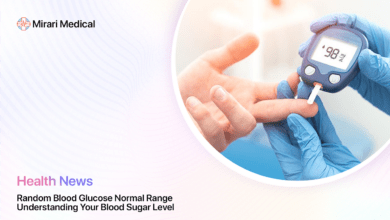How High Should Blood Sugar Be 30 Minutes After Eating?

You may be interested
Did you know that over 37 million Americans have diabetes, and 1 in 5 of them don’t even know they have it? Managing blood sugar levels is a crucial aspect of maintaining overall health, especially for those with diabetes. But even if you don’t have diabetes, understanding how your body responds to food can help you make informed choices about your diet and lifestyle. One key metric to pay attention to is your blood sugar level 30 minutes after eating. In this comprehensive guide, we’ll dive deep into what happens to your blood sugar after a meal, what levels are considered normal, and how you can keep your glucose levels in check for optimal health.
Understanding Blood Sugar Levels
Before we explore the specifics of post-meal blood sugar levels, let’s first understand the basics of blood sugar and how it’s regulated in the body.
What is Blood Sugar?
Blood sugar, also known as blood glucose, refers to the amount of sugar (glucose) circulating in your bloodstream. Glucose is the primary source of energy for your body’s cells and is derived from the food you eat, particularly carbohydrates.
How Blood Sugar is Regulated
Your body has a sophisticated system for regulating blood sugar levels, primarily through the actions of two hormones produced by the pancreas: insulin and glucagon.
- Insulin is released when blood sugar levels rise, such as after a meal. It helps cells absorb glucose from the bloodstream, lowering blood sugar levels.
- Glucagon is released when blood sugar levels fall, such as between meals or during exercise. It prompts the liver to convert stored glycogen into glucose and release it into the bloodstream, raising blood sugar levels.
This delicate balance between insulin and glucagon helps maintain blood sugar levels within a healthy range.
What Happens When Blood Sugar is Too High?
Consistently high blood sugar levels, known as hyperglycemia, can lead to various health problems over time, including:
- Damage to blood vessels and nerves
- Increased risk of heart disease and stroke
- Kidney damage
- Vision problems and blindness
- Slow wound healing and increased risk of infections
What Happens When Blood Sugar is Too Low?
On the other hand, low blood sugar levels, or hypoglycemia, can cause symptoms such as:
- Shakiness
- Dizziness
- Confusion
- Sweating
- Rapid heartbeat
- Seizures or loss of consciousness in severe cases
Maintaining blood sugar levels within a healthy range is essential for overall well-being and preventing complications.
Blood Sugar Levels After Eating
Now that we have a basic understanding of blood sugar regulation let’s focus on what happens to your glucose levels after you eat a meal.
Normal Blood Sugar Levels After Eating for Adults Without Diabetes
For adults without diabetes, normal blood sugar levels 2 hours after eating are typically less than 140 mg/dL (7.8 mmol/L). However, it’s important to note that blood sugar levels can vary depending on factors such as age, weight, and overall health.
Normal Blood Sugar Levels After Eating for Adults With Diabetes
For adults with diabetes, the American Diabetes Association recommends aiming for blood sugar levels below 180 mg/dL (10.0 mmol/L) 1-2 hours after the start of a meal. However, individual targets may vary based on factors such as age, duration of diabetes, and presence of other health conditions. It’s essential to work closely with a healthcare provider to determine personalized blood sugar goals.
Factors Affecting Blood Sugar Levels After Eating
Several factors can influence how your blood sugar responds to a meal, including:
- Carbohydrate content: Foods high in carbohydrates, particularly simple sugars and refined grains, can cause a rapid spike in blood sugar levels.
- Protein and fat content: Meals that include protein and fat can slow down the absorption of carbohydrates, leading to a more gradual rise in blood sugar.
- Portion sizes: Consuming larger portions of carbohydrate-rich foods can result in higher post-meal blood sugar levels.
- Physical activity: Engaging in physical activity before or after a meal can help lower blood sugar levels by increasing insulin sensitivity.
- Stress: Stress hormones like cortisol can cause blood sugar levels to rise.
- Medications: Some medications, such as steroids or antipsychotics, can affect blood sugar levels.
Understanding these factors can help you make informed choices about your diet and lifestyle to better manage your post-meal blood sugar levels.
Recommended Blood Sugar Ranges After Eating for Different Populations
While general guidelines exist for post-meal blood sugar levels, specific recommendations may vary based on individual factors and health conditions. Here are some examples of recommended ranges for different populations:
| Population | Recommended Blood Sugar Range 1-2 Hours After Eating |
|---|---|
| Adults without diabetes | Less than 140 mg/dL (7.8 mmol/L) |
| Adults with diabetes | Less than 180 mg/dL (10.0 mmol/L) |
| Pregnant women with gestational diabetes | Less than 120 mg/dL (6.7 mmol/L) |
| Older adults with diabetes | Less than 200 mg/dL (11.1 mmol/L) |
It’s essential to consult with a healthcare provider to determine the most appropriate post-meal blood sugar targets for your individual needs.
The Role of Carbohydrates in Blood Sugar Spikes
Carbohydrates are the primary macronutrient that directly impacts blood sugar levels. When you consume carbohydrates, your body breaks them down into glucose, which enters the bloodstream and causes a rise in blood sugar.
However, not all carbohydrates affect blood sugar levels equally. Simple carbohydrates, such as those found in sugary drinks, candy, and refined grains, are quickly absorbed and can cause rapid spikes in blood sugar. On the other hand, complex carbohydrates, such as those found in whole grains, legumes, and vegetables, are absorbed more slowly and can lead to a more gradual rise in blood sugar.
Choosing complex carbohydrates over simple carbohydrates and pairing them with protein and healthy fats can help manage post-meal blood sugar levels and prevent significant spikes.
Monitoring Blood Sugar Levels
Regularly monitoring your blood sugar levels is an essential aspect of managing diabetes and maintaining overall health. There are several methods for testing blood sugar, each with its own advantages and considerations.
Blood Sugar Testing Methods
The most common methods for testing blood sugar levels include:
- Fingerstick glucose meters: These portable devices measure blood sugar levels using a small drop of blood obtained by pricking your finger. They provide immediate results and are widely used for self-monitoring.
- Continuous glucose monitoring (CGM) systems: CGM devices use a small sensor inserted under the skin to measure glucose levels in the interstitial fluid. They provide real-time data and can alert users to high or low blood sugar levels.
- A1C tests: These laboratory tests measure your average blood sugar levels over the past 2-3 months. They provide a broader picture of your overall blood sugar control but do not capture daily fluctuations.
Your healthcare provider can help you determine the most appropriate testing method based on your individual needs and preferences.
Monitoring Blood Sugar Levels After Eating
For people with diabetes, monitoring blood sugar levels after meals can provide valuable insights into how different foods and lifestyle factors affect their glucose control. Here are some general guidelines for post-meal blood sugar monitoring:
- Test your blood sugar 1-2 hours after the start of a meal.
- Keep a record of your blood sugar readings, along with notes about the foods you ate and any physical activity or stress factors that may have influenced the results.
- Share your blood sugar logs with your healthcare provider to help identify patterns and make necessary adjustments to your treatment plan.
Regular post-meal monitoring can help you make informed decisions about your diet, medication, and lifestyle to better manage your blood sugar levels.
Interpreting Blood Sugar Readings
Understanding how to interpret your blood sugar readings is crucial for making informed decisions about your health. Here are some general guidelines for interpreting post-meal blood sugar levels:
- Normal range: Blood sugar levels below 140 mg/dL (7.8 mmol/L) 1-2 hours after eating are generally considered within the normal range for adults without diabetes.
- Elevated range: Blood sugar levels between 140-180 mg/dL (7.8-10.0 mmol/L) 1-2 hours after eating may indicate prediabetes or early-stage diabetes.
- High range: Blood sugar levels above 180 mg/dL (10.0 mmol/L) 1-2 hours after eating are considered high and may indicate poorly controlled diabetes.
It’s important to remember that individual blood sugar targets may vary based on factors such as age, duration of diabetes, and overall health. Always consult with your healthcare provider to determine your personal blood sugar goals and how to interpret your readings in the context of your unique situation.
Managing Blood Sugar Levels
Effectively managing blood sugar levels involves a combination of diet, exercise, medication (if prescribed), and lifestyle modifications. Here are some key strategies for keeping your blood sugar within a healthy range.
Diet and Exercise for Blood Sugar Control
Your diet plays a crucial role in managing blood sugar levels. Some tips for a blood sugar-friendly diet include:
- Choose complex carbohydrates, such as whole grains, legumes, and vegetables, over simple carbohydrates like sugary drinks and refined grains.
- Pair carbohydrates with protein and healthy fats to slow down glucose absorption and prevent significant blood sugar spikes.
- Practice portion control, especially with carbohydrate-rich foods.
- Limit your intake of added sugars and processed foods.
- Stay hydrated by drinking water throughout the day.
Regular physical activity is also essential for managing blood sugar levels. Exercise helps improve insulin sensitivity, allowing your body to use glucose more effectively. Aim for at least 150 minutes of moderate-intensity aerobic activity per week, along with muscle-strengthening activities at least twice a week.
Medication for Blood Sugar Control
For some people with diabetes, medication may be necessary to help manage blood sugar levels. Common types of diabetes medications include:
- Insulin: Insulin injections or pumps help replace the insulin that the body is not producing or using effectively.
- Oral medications: Various oral medications, such as metformin, sulfonylureas, and DPP-4 inhibitors, work in different ways to help lower blood sugar levels.
- GLP-1 receptor agonists: These injectable medications slow down digestion and help the body produce more insulin when blood sugar levels are high.
Your healthcare provider will work with you to determine the most appropriate medication regimen based on your individual needs and medical history.
Lifestyle Changes for Blood Sugar Management
In addition to diet, exercise, and medication, making certain lifestyle changes can help you better manage your blood sugar levels. Some key lifestyle modifications include:
- Stress management: Engaging in stress-reducing activities, such as meditation, deep breathing, or yoga, can help lower stress hormones that can raise blood sugar levels.
- Adequate sleep: Aim for 7-9 hours of quality sleep each night, as poor sleep can negatively impact insulin sensitivity and blood sugar control.
- Avoiding smoking and excessive alcohol consumption: Both smoking and excessive alcohol intake can contribute to insulin resistance and make blood sugar management more challenging.
- Regular check-ups: Schedule regular appointments with your healthcare provider to monitor your blood sugar levels, adjust your treatment plan as needed, and screen for potential complications.
Incorporating these lifestyle changes into your daily routine can help you better manage your blood sugar levels and improve your overall health.
Potential Complications of High Blood Sugar
Consistently high blood sugar levels can lead to a range of complications affecting various parts of the body. It’s essential to be aware of these potential complications and take steps to prevent or manage them.
Short-Term Complications of High Blood Sugar
Some short-term complications of high blood sugar include:
- Diabetic ketoacidosis (DKA): This serious condition occurs when the body doesn’t have enough insulin, leading to a buildup of ketones in the blood. Symptoms include excessive thirst, frequent urination, nausea, abdominal pain, and fruity-smelling breath.
- Hyperosmolar hyperglycemic state (HHS): This life-threatening condition occurs when blood sugar levels become very high, leading to severe dehydration. Symptoms include extreme thirst, confusion, fever, and vision problems.
If you experience symptoms of DKA or HHS, seek immediate medical attention, as these conditions can be life-threatening if left untreated.
Long-Term Complications of High Blood Sugar
Over time, consistently high blood sugar levels can lead to various long-term complications, including:
- Cardiovascular disease: High blood sugar can damage blood vessels and increase the risk of heart disease, stroke, and peripheral artery disease.
- Nerve damage (neuropathy): Prolonged exposure to high blood sugar can damage nerves throughout the body, leading to numbness, tingling, pain, and weakness.
- Kidney damage (nephropathy): High blood sugar can damage the blood vessels in the kidneys, leading to kidney disease and potential kidney failure.
- Eye damage (retinopathy): High blood sugar can damage the blood vessels in the eyes, potentially leading to vision problems and blindness.
- Foot problems: Nerve damage and poor circulation resulting from high blood sugar can lead to foot ulcers, infections, and, in severe cases, amputation.
Regular blood sugar monitoring, adherence to treatment plans, and adopting a healthy lifestyle can help prevent or delay the onset of these complications.
Seeking Professional Advice
Managing blood sugar levels and preventing complications requires a team approach, with you and your healthcare providers working together to develop and implement an effective treatment plan.
Consulting a Healthcare Professional
If you have concerns about your blood sugar levels or are experiencing symptoms of diabetes, it’s essential to consult with a healthcare professional. Your primary care physician can perform initial assessments and refer you to specialists, such as endocrinologists or diabetes educators, as needed.
During your appointments, be prepared to discuss your:
- Medical history
- Family history of diabetes
- Current medications and supplements
- Diet and exercise habits
- Any symptoms you may be experiencing
Your healthcare provider will use this information, along with blood sugar tests and physical examinations, to diagnose diabetes or prediabetes and develop an appropriate treatment plan.
Understanding Your Individual Blood Sugar Targets
As mentioned earlier, blood sugar targets can vary based on individual factors and health conditions. Your healthcare provider will work with you to determine your personal blood sugar goals, taking into account your:
- Age
- Type and duration of diabetes
- Presence of other health conditions
- Risk of hypoglycemia
- Overall health and life expectancy
Understanding your individual blood sugar targets is crucial for effectively monitoring and managing your glucose levels.
Developing a Personalized Blood Sugar Management Plan
In collaboration with your healthcare team, you’ll develop a personalized blood sugar management plan tailored to your unique needs and goals. This plan may include:
- A specific diet plan, focusing on complex carbohydrates, lean proteins, and healthy fats
- An exercise regimen that includes both aerobic and strength training activities
- Medications, such as insulin or oral diabetes drugs, if necessary
- A blood sugar monitoring schedule and target ranges
- Strategies for managing stress and other lifestyle factors that can impact blood sugar levels
Regularly reviewing and adjusting your management plan with your healthcare team can help you stay on track and achieve optimal blood sugar control.
In conclusion, understanding how high your blood sugar should be 30 minutes after eating is a crucial aspect of managing your overall health, especially if you have diabetes. By monitoring your post-meal glucose levels, adopting a healthy diet and lifestyle, and working closely with your healthcare team, you can keep your blood sugar within a healthy range and reduce your risk of complications. Remember, everyone’s blood sugar targets are unique, so it’s essential to consult with your healthcare provider to determine the best approach for your individual needs. With the right knowledge, tools, and support, you can take control of your blood sugar and live a healthy, vibrant life.
Your trusted source for health info, offering expert advice, news, and tips to stay healthy and informed.





